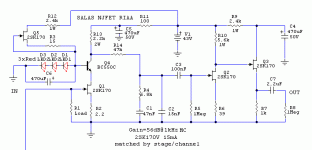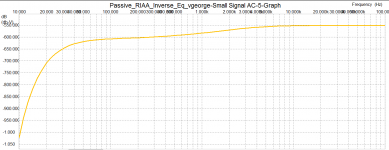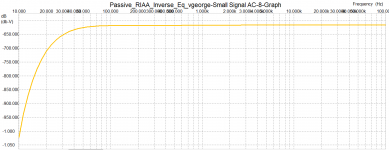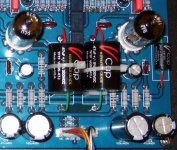It maybe part the components quality part the subtle value fixes but we must not forget that George has speakers that let him hear things that our systems may well hide, and we probably can't relate directly to what exactly he hears more. I know because I had listened to them carefully since we had to judge and fine tune their 3way crossover we made. Those are large scale modular horns of the best ilk. Aided by high sens & power huge active subs. 4 way multi amplified system in total.
Salas, where is latest schematic. I have to mak emy brother a birthday present and he is a vinyl man. This seems like agood choice tome, although i am not to sure about the guy who came up with it For christmas he is getting the paradise. Both will try to unseat his conrad johnson. He likes glowplugs. People these days.
For christmas he is getting the paradise. Both will try to unseat his conrad johnson. He likes glowplugs. People these days.
From what I remember FT-3 was a little bit more mellow sound, but I got more information and better highs from K-72. Maybe more accurate.
Also FT-3 was 100n and K-72 47n.
I got bigger improvement by changing these 2 resistors, something I didn' t expect to be really honest.
FT-3 comes across more mellow and K-72 a bit edgier when using tweeters in my experience but that may well be more info in reality that does not bother the Le' Cleach with the land mine size Great Plains driver you use almost over to 10kHz. It could be highlighting 3rd order nasties in one inch low crossed tweeters on the other hand. Which even the best are toys in dynamics VS THD comparison to such horns. So it can be working better for you. Those Z Foils are technically superior resistors indeed, but parts outlay must always go in tandem with the resolution that an installation can provide as a whole. I.e. logical in your case. So get/make the best speakers you can in good proportion to the room before spending lavishly in parts is a good rule of thumb for any of us IMHO. Orelli had great results too but look at his speakers and room treatment...Impressive. (#7849 & #7850).
Salas, where is latest schematic. I have to mak emy brother a birthday present and he is a vinyl man. This seems like agood choice tome, although i am not to sure about the guy who came up with itFor christmas he is getting the paradise. Both will try to unseat his conrad johnson. He likes glowplugs. People these days.
Its all in the PDF linked from post #1. The mods you see I breadboard lately are not properly developed or confirmed positive yet. But some parts I needed are on their way.
Hi Ricardo,
here are the values I used :
R4=6,790K
C1=46,94nF
C2=15,080nF
C3=47nF
R14=46,93K
R1=180R
Salas, room treatment, I know, is on my shortlist for the winter!
Hi vgeorge
I also need R13 and R5 real values.
How much second stage Miller is allowed for that graph?
Based on my experience I used 900p
Yes, I know you have been there so you know it is very good. The new 47k resistor difference is very small so it should not matter much.
Anyway the first graph looks way cool to me.
Maybe vgeorge wants to experiment... resistors in aligators are simple to use... we will learn from the outcome.
Anyway the first graph looks way cool to me.
Maybe vgeorge wants to experiment... resistors in aligators are simple to use... we will learn from the outcome.
Salas,
Now that my pre amp is complete. I am fretting over the output coupling cap used in this design. I want to use the best and a V-Cap TFTF seems to be the favorite, that I can't afford. You have a 2.2 uF cap but into a DCB1 with a 22k ohms pot it really should be a 4 uF cap.
Normally with a single ended supply like the Simplistic NJFET RIAA you have no choice but to cap couple the output.
But with my setup, I do have a -DC regulated supply available.
What would we be able to do? How about a DCB1 with a trimmer resistor in the lower leg?
Rush
Now that my pre amp is complete. I am fretting over the output coupling cap used in this design. I want to use the best and a V-Cap TFTF seems to be the favorite, that I can't afford. You have a 2.2 uF cap but into a DCB1 with a 22k ohms pot it really should be a 4 uF cap.
Normally with a single ended supply like the Simplistic NJFET RIAA you have no choice but to cap couple the output.
But with my setup, I do have a -DC regulated supply available.
What would we be able to do? How about a DCB1 with a trimmer resistor in the lower leg?
Rush
2nd stage is sitting the buffer's gate at its VDS potential around 10V. So it centers there and carries it to the output. Now if the DC blocking could be transported to the buffer's input with a much lower value cap by using a 1-2meg gate to ground resistor for it, and there is a (-) adj supply available, we probably could make the output buffer like a DCB1 by matching the Jfets and the phono's (+) supply value available to the buffer after the RC at top right in simplistic's schematic. At least a quick thought. There are many highly regarded caps somewhat easier to pay for when the value is say 0.1uF or under. Maybe you would like a Jupiter as much or a Multicap RTX to give two opposite materials tech used between them examples. V-Caps I had put in a commercial phono that its owner bought for and asked me to fit, they did not impress me much for the money, still clean and smooth no doubt, could hear the upgrade. It had Hovland caps originally. Bigger upgrade was when I worked around the input circuit and tried a better suitable more linear tube type, cutting on noise also due to formerly excess gain. He adopted them after listening himself no matter how obsessed with his Telefunkens.
Attachments
V-Cap TFTF
The V-Caps need a bunch of time on them to sound their best.
See attached capacitor shoot out, if you haven't already.
Rush
2nd stage is sitting the buffer's gate at its VDS potential around 10V. So it centers there and carries it to the output. Now if the DC blocking could be transported to the buffer's input with a much lower value cap by using a 1-2meg gate to ground resistor for it, and there is a (-) adj supply available, we probably could make the output buffer like a DCB1 by matching the Jfets and the phono's (+) supply value available to the buffer after the RC at top right in simplistic's schematic. At least a quick thought. There are many highly regarded caps somewhat easier to pay for when the value is say 0.1uF or under. Maybe you would like a Jupiter as much or a Multicap RTX to give two opposite materials tech used between them examples. V-Caps I had put in a commercial phono that its owner bought for and asked me to fit, they did not impress me much for the money, still clean and smooth no doubt, could hear the upgrade. It had Hovland caps originally. Bigger upgrade was when I worked around the input circuit and tried a better suitable more linear tube type, cutting on noise also due to formerly excess gain. He adopted them after listening himself no matter how obsessed with his Telefunkens.
The V-Caps need a bunch of time on them to sound their best.
See attached capacitor shoot out, if you haven't already.
Rush
Attachments
- Home
- Source & Line
- Analogue Source
- Simplistic NJFET RIAA




